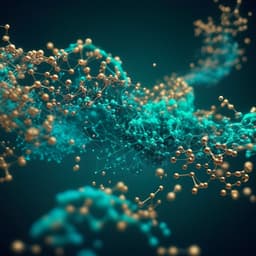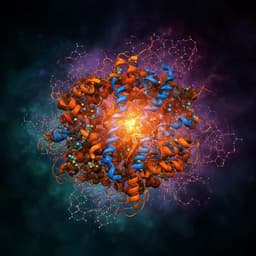
Medicine and Health
Integrated multi-omics analyses reveal homology-directed repair pathway as a unique dependency in near-haploid leukemia
Y. Liu-lupo, J. D. Ham, et al.
This groundbreaking research conducted by Yunpeng Liu-Lupo, James Dongjoo Ham, Swarna K. A. Jeewajee, Lan Nguyen, Toni Delorey, Azucena Ramos, David M. Weinstock, Aviv Regev, and Michael T. Hemann reveals the unique genetic dependency of near-haploid acute lymphoblastic leukemia (ALL) on the RAD51B gene, proposing it as a promising therapeutic target. Utilizing single-cell RNA sequencing, the study uncovers essential insights into the DNA repair mechanisms that are critical for the survival of these cancer cells.
~3 min • Beginner • English
Introduction
Acute lymphoblastic leukemia (ALL), particularly B-ALL, often exhibits whole-chromosome copy number aberrations ranging from near-tetraploidy to near-haploidy. Hypodiploidy, especially near-haploidy (24–29 chromosomes), is associated with poor prognosis and treatment resistance, including cases of masked hypodiploidy that can be misdiagnosed as hyperdiploidy and relapse with the original hypodiploid clone. Given that massive chromosome loss is poorly tolerated in normal cells, the study asks how near-haploid leukemia cells maintain viability and why these karyotypes confer poor outcomes. Prior reports identified recurrent RTK/Ras pathway mutations and suggested PI3K pathway vulnerabilities, and p53-dependent disadvantages in haploid KBM7 cells, but the mechanistic basis for haploid-specific vulnerabilities remained unclear. The purpose here is to define unique physiological features and genetic dependencies of near-haploid leukemia by integrating single-cell transcriptomics, computational cell-cycle modeling, and genome-wide functional screens, with a focus on identifying targetable pathways that underlie treatment resistance.
Literature Review
Key prior findings include: (1) Near-haploid and hypodiploid B-ALL correlate with inferior event-free survival; masked hypodiploid cases often relapse from the hypodiploid lineage. (2) Genomic profiling of 124 hypodiploid ALL cases revealed recurrent RTK/Ras signaling mutations and IKZF3 alterations, implicating PI3K pathway inhibition as a potential therapy, though such alterations also occur in other leukemias. (3) In the near-haploid CML line KBM7 and haploid mouse ES cells, p53 loss improved viability and reduced diploidization, indicating a p53-dependent constraint on haploid viability, but without clarifying the molecular pathways conferring haploid-specific vulnerabilities. These studies framed the need to uncover unique, potentially targetable dependencies specific to near-haploid states beyond general oncogenic signaling abnormalities.
Methodology
- Cell lines and culture: Near-haploid and diploidized KBM7 CML cells were cultured in IMDM with 10% FBS, antibiotics, and β-mercaptoethanol; K562 (near-triploid) cultured in RPMI. Mycoplasma testing negative. Haploid and diploid KBM7 single-cell clones were used for key assays.
- Cell-cycle profiling: (1) Single-parameter DNA content using Hoechst 33342 and FlowJo Watson Pragmatic modeling to estimate G1/S/G2M proportions. (2) Two-parameter analysis with BrdU pulse (10 μM, 2 h) and 7-AAD for total DNA content.
- Bulk RNA-seq: FACS-sorted live KBM7 cells (3 clones per ploidy) into TCL buffer with ERCC spike-ins; SMART-seq2 library prep; Illumina HiSeq 2000 PE75. Reads mapped with STAR (hg19), quantified with RSEM; ERCC-based normalization; differential analysis with Seurat.
- Genome-wide CRISPR knockout screen: Cas9-expressing KBM7 transduced with an optimized lentiviral sgRNA library (76,441 sgRNAs, targeting 19,114 genes) at ~40% efficiency; 1000X input coverage, 500X maintained coverage; puromycin selection; cultured ~20 doublings; harvested 100M diploid and 300M haploid cells; gDNA extraction and sequencing; STARS (v1.3) for sgRNA ranking (parameters: -threshold=30, -num-ite=1000, --use-first-pert=N); GSEA (v3.0) against REACTOME pathways for haploid-specific depleters.
- RAD51B perturbations: (1) Doxycycline-inducible shRNA knockdown (two hairpins) in a miR-30 backbone co-expressing E2-Crimson; Renilla shRNA as control; retroviral transduction and FACS sorting; growth competition assays post-induction; western validation. (2) CRISPR-Cas9 knockout: Cas9+ KBM7 infected with sgRNAs targeting RAD51B (two guides) or LacZ control; tdTomato selection; cloning of single cells; RAD51B loss confirmed by western; editing characterized by PCR/Sanger and TIDE.
- Immunofluorescence for DNA damage and HR foci: Cells stained for γ-H2AX (DSB marker) and RAD51, secondary Alexa Fluor antibodies; DAPI for nuclei; imaging by Nikon fluorescence microscopy; foci quantification with CellProfiler. DAPI intensity used to bin cells into G1/S, S, G2/M proxies.
- Single-cell RNA-seq: (1) KBM7: 10x Genomics Chromium 3’ v2; 7,000–20,000 cells per channel; Illumina HiSeq 2000 PE38; Cell Ranger v3 for mapping (hg19), UMI counting, mitochondrial content filtering; MAGIC (t=3) imputation; variable gene filtering. (2) Patient-derived xenograft (PDX) B-ALL: Near-haploid and diploidized cells isolated from NSG mice bone marrow and spleen; hashtag oligo-conjugated antibodies for multiplexing; 10x v2, Cell Ranger v3; Seurat v3 for normalization, variable gene selection, and CCA-based integration.
- Computational cell-cycle inference: Cell-cycle signature genes (G1/S, S, G2, G2/M, M/G1) from Whitfield et al.; retained genes with UMI>0 in ≥5% cells and Pearson r ≥0.5 with signature average; assigned phase by highest signature score. Fitted an elliptical manifold to G2M–G1S score space; rolling circular window (radius 0.5) to estimate pseudo-time expression; 95% CI from 1.96×SEM.
- PDX model and chemotherapy: Near-haploid B-ALL (28XY; trisomy 14 and 21) established as PDX in NSG mice; diploidized cells arose on passage. Mice treated when CD19+ cells reached 5%: Days 1–5 dexamethasone (5 mg/kg) and L-asparaginase (1000 U/kg), Day 6 vincristine (0.15 mg/kg), Day 7 doxorubicin (2 mg/kg). Harvested 48 h post-doxorubicin for scRNA-seq and analyses.
- RAD51B-associated signature: From KBM7 scRNA-seq, genes with Pearson correlation r ≥ 0.5 with RAD51B comprised the signature; signature scores averaged on MAGIC-imputed, CCA-integrated PDX scRNA-seq (t=7).
- Patient cohort analysis: Affymetrix microarray data (GEO GSE27237) of hypodiploid and masked hypodiploid B-ALL; normalized with limma; PCA and evaluation of RAD51B expression and RAD51B signature enrichment across karyotype groups.
- Statistics: GraphPad Prism; Wilcoxon rank-sum, Student’s t-tests, Kolmogorov–Smirnov for GSEA, Benjamini–Hochberg corrections as specified.
Key Findings
- Growth and cell cycle differences: Near-haploid KBM7 proliferated more slowly than diploidized counterparts (doubling time difference ~0.5 h; ~3% slower; p=0.034). Haploid cells had increased G2/M fraction and decreased S-phase fraction by Hoechst modeling (G2/M p=0.0002; S p=0.026) and by BrdU/7-AAD two-parameter analysis (G2/M enrichment p=0.0015). Estimated that haploid cells spend ~0.7 h longer in G2/M.
- Transcriptomics: Bulk RNA-seq revealed ~2:1 global expression ratio (diploid:haploid) with no large per-gene changes after ERCC normalization. scRNA-seq confirmed 2:1 global ratio but uncovered stage-specific abnormalities: altered cyclin dynamics (e.g., cyclin D1 peaking abnormally in late S/G2/M in haploid), and the largest deviations from the expected 2:1 expression ratio in G2/M and M/G1.
- HR pathway involvement: RAD51 and RAD51B showed altered, bi-modal expression peaks (early S and late G2/M) in haploid cells, versus late S/early G2 in diploid, indicating altered HR engagement across the cycle.
- CRISPR screens: Genome-wide knockout screens identified RAD51B as a top haploid-specific essential gene, with strong sgRNA depletion in haploid but not diploid KBM7. RAD51 itself was essential in both contexts. Cross-referencing DepMap and other hematologic screens highlighted six genes uniquely essential in haploid KBM7 among those upregulated in haploid cell-cycle stages: RAD51B, SLC38A5, MTIF2, LIG3, SRM, SHMT2.
- Functional validation: Doxycycline-inducible shRNA knockdown and CRISPR knockout of RAD51B reduced fitness selectively in haploid KBM7. In clones, RAD51B loss increased G2/M fraction more in haploid (19.3% vs 11.2% control) than diploid (12.3% vs 9.5%).
- DNA damage and HR foci: Baseline γ-H2AX foci scaled roughly with DNA content for diploid vs triploid cells, but diploid:haploid γ-H2AX ratio was ~1:1, not the expected 2:1 (p=0.015), implying relatively more unrepaired DSBs in haploid cells. DAPI-binned analysis showed significant deviation from expected diploid:haploid ratios in G2/M for γ-H2AX (p=0.04) and RAD51 foci (p=0.021). Co-localization of RAD51 at γ-H2AX foci was higher in haploid specifically at G2/M (p=0.042). RAD51B knockout significantly reduced RAD51–γ-H2AX co-localization in G2/M haploid cells (p=0.004), indicating compromised RAD51 recruitment/HR efficiency.
- PDX model response: In vivo chemotherapy (VXDL) elicited strong responses; scRNA-seq of 11,922 leukemia cells showed that a RAD51B co-expression signature increased significantly upon treatment in near-haploid B-ALL bone marrow and spleen (BM p<2.2×10^-16; SP p=0.0017), but not in diploidized B-ALL (p=0.424). Unsupervised clustering (8 clusters) revealed ploidy-dependent state distributions; near-haploid BM cells were enriched in Cluster 2 after treatment (26.1% vs 14.9% vehicle), characterized by high expression of mitotic spindle and DNA replication initiation genes (e.g., TUBB, PCNA), and overlapping RAD51B signature genes (21 shared; hypergeometric p=1.59×10^-7).
- Patient data: Pediatric hypodiploid B-ALL microarray data showed a marked enrichment of the RAD51B signature and higher RAD51B expression in near-haploid versus masked or low-hypodiploid subtypes (selected pairwise comparisons significant; e.g., p=0.0016 and p=0.018), supporting clinical relevance of RAD51B dosage/programs in near-haploid disease.
Discussion
The study demonstrates that near-haploid leukemia cells exhibit altered cell-cycle progression with prolonged G2/M and aberrant cell-cycle gene expression programs. Integrating scRNA-seq–based cell-cycle stage inference with genome-wide CRISPR screens revealed a unique dependency on the homologous recombination factor RAD51B specifically in near-haploid cells. Mechanistically, haploid cells display increased relative DSB burden and heightened reliance on RAD51-mediated repair in G2/M. Loss of RAD51B selectively impairs RAD51 co-localization to DNA damage foci during G2/M in haploid cells, indicating a stage-specific vulnerability that does not manifest in diploid cells, which may possess compensatory mechanisms. In vivo, near-haploid B-ALL mounts a RAD51B-associated G2/M and G1/S checkpoint response to chemotherapy, enriching for a cell state characterized by spindle and replication programs that overlaps the RAD51B signature. The enrichment of RAD51B expression and its signature in patient near-haploid B-ALL further supports a disease-intrinsic dependency on HR components. Together, these findings answer the central question by identifying HR—and RAD51B in particular—as a selective liability in near-haploid leukemia, providing a mechanistic link between ploidy, DNA repair stress, and therapeutic response.
Conclusion
By combining single-cell transcriptomics, computational cell-cycle modeling, and genome-wide functional genomics, the study identifies a unique dependency of near-haploid leukemia on RAD51B-mediated homologous recombination, especially during G2/M. This dependency manifests as impaired RAD51 recruitment to DSBs upon RAD51B loss and heightened RAD51B-associated checkpoint programs in response to genotoxic therapy in vivo. RAD51B emerges as a promising therapeutic target for treatment-refractory near-haploid leukemia. Future work should: (1) evaluate pharmacologic strategies to inhibit RAD51B functions or HR selectively in near-haploid contexts; (2) extend validation to additional hypodiploid models and patient-derived samples; (3) dissect compensatory pathways in diploid cells; and (4) explore crosstalk between HR and mitochondrial processes implicated by additional haploid-specific essential genes (e.g., SHMT2, MTIF2).
Limitations
- Limited availability of culturable hypodiploid cell lines and stable xenograft samples constrained breadth of validation; findings should be extended in additional models as they become available.
- Genetic manipulation of human xenograft B-ALL samples was challenging, limiting in vivo loss-of-function tests for RAD51B in near-haploid B-ALL.
- While RAD51B dependency is robust in KBM7 and supported by PDX expression programs and patient data, generalizability across diverse hypodiploid leukemias and other lineages remains to be established.
- The study did not identify the exact compensatory mechanisms in diploid cells that buffer RAD51B loss, nor fully delineate molecular interfaces between HR and mitochondrial pathways suggested by screening results.
Related Publications
Explore these studies to deepen your understanding of the subject.







